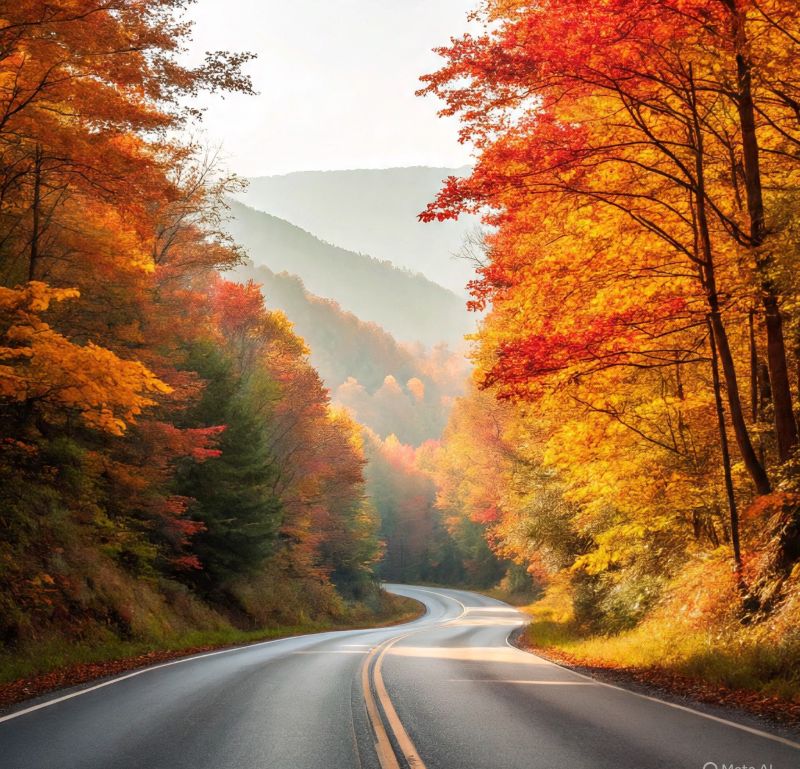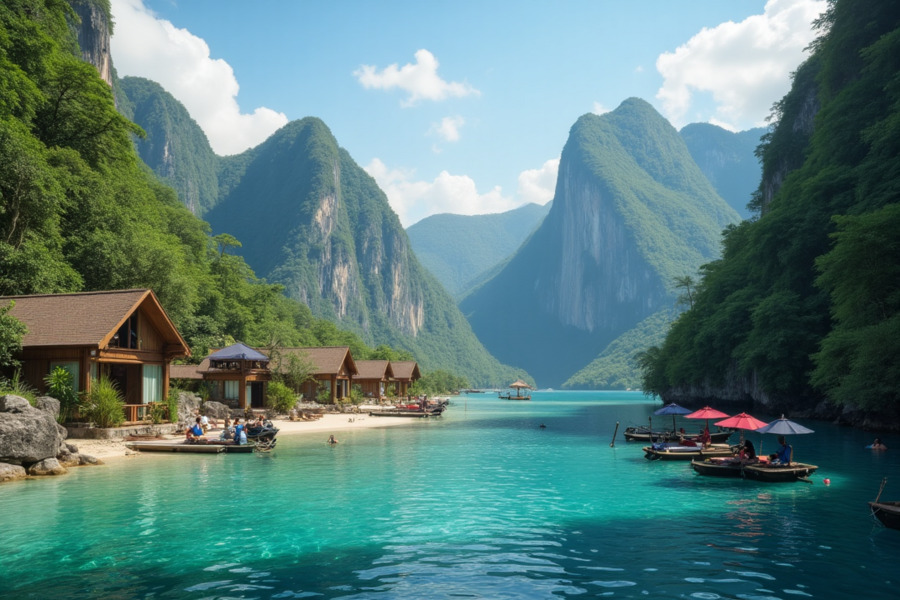≡-West Virginia and Its Brilliant Fall Foliage How the New Autumn Projection Map Is Shaping Seasonal Travel Cultural Heritage and Tourism Growth in the United States – Viral of Today
<> Viral of Today <>
Home » Latest Travel News of United States » West Virginia and Its Brilliant Fall Foliage How the New Autumn Projection Map Is Shaping Seasonal Travel Cultural Heritage and Tourism Growth in the United States Published on
September 5, 2025West Virginia and the 2025 Fall Foliage Projection Map have been positioned at the center of discussions surrounding seasonal tourism in the United States. Observers suggested that the Mountain State was preparing not only for a stunning display of colors but also for an ambitious model of autumn travel that could influence destinations far beyond American borders.Reports indicated that a mixture of above-average summer rainfall, warm daylight hours, and crisp night temperatures had created the perfect environment for an unusually vivid palette of reds, oranges, and golds. The projection map was presented as a tool for both residents and travelers, offering insight into when and where the colors would peak.However, experts insisted the season was more than a natural show. They described fall in West Virginia as an economic engine, a cultural celebration, and an authentic travel experience. By integrating breathtaking landscapes, local traditions, and digital resources, the state appeared ready to offer an autumn unlike any other.The Story Behind the Grist Mill at Babcock State ParkAnalysts often emphasized the symbolic power of the Glade Creek Grist Mill at Babcock State Park. Despite its rustic charm suggesting deep historical roots, it was revealed that the mill was constructed in 1976. Even so, its wooden beams, stone foundation, and turning wheel created an illusion of timeless Appalachian heritage.The structure was said to embody more than architecture—it represented cultural identity. For decades, the mill had been immortalized in paintings, photographs, and travel literature, reinforcing its place as one of West Virginia’s most iconic landmarks. During autumn, the surrounding forest transformed the site into a dramatic canvas of color, attracting photographers, hikers, and casual travelers alike.By preserving this emblem, the state demonstrated how cultural heritage could enhance natural scenery, blending history and landscape into a single attraction that resonated globally with visitors seeking depth in their travel experiences.Why West Virginia Stands Out for Fall FoliageSpecialists pointed out that the uniqueness of West Virginia’s autumn was rooted in its geography and biodiversity. The elevation ranged from just under 300 feet to more than 4,800 feet, creating a gradual unfolding of color across valleys, ridges, and mountain ranges.Instead of a quick and fleeting peak, the transformation stretched across more than a month, giving visitors extended opportunities to enjoy the spectacle. This gradual change was contrasted with destinations where color peaked quickly, leaving only narrow windows for tourists.Climate also played a pivotal role. Warm days combined with cool nights accelerated the breakdown of chlorophyll, while heavy summer rains ensured healthy, dense foliage. Observers explained that this created one of the most vibrant displays in recent memory. Species like red maples, sugar maples, oaks, hickories, and birches painted the mountains with a broad spectrum of tones, creating what many described as a living mosaic of color.The Importance of Protected Natural AreasA critical strength of the Mountain State was its wealth of protected lands. Reports highlighted that more than seventy-five state parks, forests, and wildlife areas, alongside national sites such as the Monongahela National Forest and the New River Gorge National Park and Preserve, provided visitors with unparalleled access to the autumn season.These locations were seen as more than scenic backdrops. They provided immersive opportunities to hike, kayak, climb, or simply pause at overlooks to absorb the landscape. Places like Blackwater Falls State Park and the Highland Scenic Highway were singled out for their combination of waterfalls, panoramic views, and kaleidoscopic foliage.Observers emphasized that conservation efforts preserved not just the present season but safeguarded it for generations. Maintaining these lands ensured that visitors worldwide could continue to enjoy authentic and sustainable autumn travel in West Virginia.Autumn Adventures with a TwistBeyond the traditional leaf-peeping experiences, West Virginia was preparing a distinctive addition to its seasonal attractions. The West Virginia Paranormal Trail was scheduled to return, incorporating haunted sites, ghost stories, and folklore into autumn itineraries.This initiative was believed to add layers of mystery and intrigue to the travel experience. For some, the opportunity to combine scenic drives and vibrant foliage with tales of history and the supernatural created a uniquely memorable journey.Analysts suggested that this blending of cultural storytelling and natural wonder broadened the appeal of the season, drawing not only traditional foliage enthusiasts but also travelers seeking something different. By offering unusual adventures, the state demonstrated how creative programming could set one destination apart in the crowded global travel market.Weekly Itineraries for Leaf-PeepersStarting in mid-September, curated weekly itineraries were developed to maximize travelers’ experiences. Each schedule highlighted routes, small towns, and regions most likely to showcase peak colors. Cultural festivals, harvest events, and outdoor activities were seamlessly integrated into these journeys.Travelers could expect:Scenic drives along winding mountain roads enveloped in vibrant leaves.Hiking trails leading to panoramic overlooks.Visits to towns hosting autumn festivals rooted in Appalachian traditions.Seasonal harvest celebrations offering food, music, and cultural performances.Observers explained that these itineraries allowed travelers to plan with precision. The Live Leaf Tracker updated stages of foliage in real time—from green to patchy, partial, peak, and past peak. This digital integration ensured that visitors arrived at the right location during the most vivid displays. Analysts described this mix of technology and nature as a hallmark of West Virginia’s 2025 season.West Virginia Peak Color ForecastThe 2025 Fall Foliage Projection Map laid out a detailed timeline of peak colors across the state:Late September to Early October – Early color changes in the Allegheny Mountains at higher elevations.Early to Mid-October – Vibrancy spreads through mid-elevation ridges and valleys.Mid to Late October – Low-lying river regions and valleys begin their transformation.Late October to Early November – Southern counties and hills reach their peak.While weather conditions could cause slight adjustments, officials indicated that the Live Leaf Tracker would keep travelers informed in real time. Observers noted that this forecasting ability gave visitors unparalleled accuracy, ensuring their journeys aligned with the state’s most spectacular weeks.Why Autumn Travel in West Virginia Matters GloballyAnalysts described West Virginia’s strategies as a blueprint for global seasonal tourism. Tools such as the foliage map, live trackers, and curated itineraries demonstrated how digital resources could complement natural attractions.They stressed that modern travelers increasingly preferred authentic and sustainable experiences over standardized tourism. By combining cultural authenticity, natural diversity, and digital innovation, the Mountain State was setting an example for destinations worldwide.This approach, it was suggested, avoided the pitfalls of over-commercialization while strengthening community inclusion. Observers argued that the balance achieved in West Virginia could inspire similar strategies in regions as diverse as Europe, Asia, and South America.The Economic and Cultural DimensionsExperts emphasized that autumn in West Virginia was more than a visual delight—it was a lifeline for local economies. Seasonal festivals, markets, and celebrations drove revenue into rural communities, where tourism played a crucial role in supporting livelihoods.Visitors weren’t just spectators; they were participants in cultural traditions. Activities such as apple picking, corn mazes, pumpkin patches, and cider-making allowed travelers to step into the rhythms of Appalachian life. Analysts highlighted this authenticity as a distinguishing factor.Instead of mass-market attractions, West Virginia presented an autumn rooted in heritage and community. This blend of economic vitality and cultural preservation reinforced the notion that fall in the Mountain State represented more than a season—it was a celebration of identity.Global Implications for the Travel IndustryFinally, observers concluded that West Virginia’s 2025 fall season was not merely about showcasing local beauty but about setting a tone for international travel. Its fusion of conservation, culture, and digital access reflected an evolving global trend where tourism was expected to be authentic, inclusive, and sustainable.For travelers worldwide, this meant that autumn journeys could go beyond sightseeing. They could become opportunities for meaningful connections with landscapes, traditions, and communities. The Mountain State was thus portrayed not just as a domestic destination but as a global model for seasonal tourism in the twenty-first century.
This information will surprise you!
See also
- Read until the end to discover everything.
- Important information you need to know.
- Interesting facts and helpful tips.
Conclusion
Did you enjoy the news? Keep following us daily!













